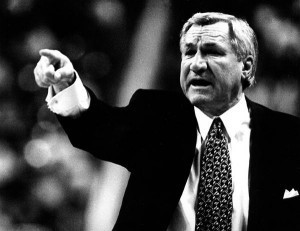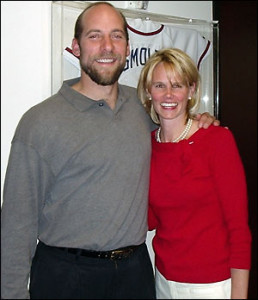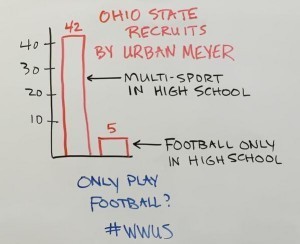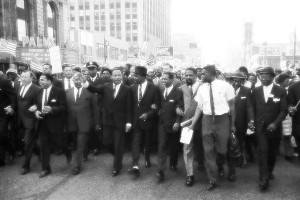Molly Fletcher's Blog, page 24
March 3, 2015
Here’s Rule No. 1 for Effective Communication
Successful people connect with others by taking risks. They communicate effectively because they welcome difficult conversations.
connect with others by taking risks. They communicate effectively because they welcome difficult conversations.
This is a very difficult skill to master, because most of us avoid difficult conversations. But if you want to connect, you must dare to move in the opposite direction—and learn to embrace these tough dialogues.
Here’s how.
Practice by identifying a relationship that needs work. What conversations have you been avoiding? Where are the pressure points that need attention? I learned how important this was when I represented Florida coach Billy Donovan, whose pro deal fell apart because we didn’t have the tough conversation around questions like, “Are you ready to look the players you recruited in the eyes and tell them you are leaving for the pros? Are you prepared to walk into your athletic director’s office, who has supported you for years, and tell him ‘I’m moving on?’”
Name the issue. Make it simple and to the point. This can take a lot of upfront work. As I covered in an earlier blog, the hardest thing to do is to pare down you point to a single sentence or priority. Work ahead of the conversation to get to the essence of what you are trying to say.
When breaking down the issue, remember the acronym SBI (Situation, behavior and impact.) The situation is the context for your relationship. The behavior is the specific action that is happening—or not happening—to cause the conflict. Impact is the results of the first two; it answers the question, “What’s at stake?
Ditch the script. Invite your counterpart to respond. Really listen. Remain open, and practice observing your defensiveness without judgment. Ask questions. Openness is an invitation to greater trust.
End with clarity. Ask, “What have we learned? Where do we stand now? How do we move forward?” This is your call to action or summons to go forth in a more authentic partnership.
For more tips on mastering this No. 1 rule for effective communication, look for great resources like Susan Scott’s book, “Fierce Conversations: Achieving Success at Work and in Life One Conversation at a Time.”
Remember: Because our relationships are rooted in conversations, the quality of our relationships depend on the quality of our conversations. People who want to be successful want to connect through strong relationships, and this goal requires engaging in effective communication.
Your Game Changer Takeaway
Rule No. 1 for effective communication is to embrace difficult conversations. If you want to go swimming, you’re going to get wet, and that’s the same deal with building strong connections with others that lead to success. Choose a tip from this blog post to make your next difficult conversation a steppingstone to greater connection.
Molly Fletcher helps inspire and equip game changers to lead well and with purpose. Her book, “ A Winner’s Guide to Negotiating: How Conversation Gets Deals Done ” (McGraw-Hill, 2014), draws on her decades as a sports agent and negotiator on behalf of pro athletes, coaches and broadcasters. Follow Molly on Twitter @MollyFletcher.
February 24, 2015
Skip Other Goal Setting Tips and Do This One
Because of our  brain wiring, the facts and figures that we remember the most are attached to stories. That’s the reason that detailed visualization is at the top of my most effective goal setting tips. If you’re not creating a story for yourself as the star performer, you need to be. It’s a fantastic habit that will drive you to amazing achievement.
brain wiring, the facts and figures that we remember the most are attached to stories. That’s the reason that detailed visualization is at the top of my most effective goal setting tips. If you’re not creating a story for yourself as the star performer, you need to be. It’s a fantastic habit that will drive you to amazing achievement.
We’ve talked about the power of writing down a goal completely and in present tense as a way of making it real. Visualization doubles down on that. You make that desire come to life.
As you visualize, can you taste the champagne after that big deal is inked? How about the smell of the brand new car you’ve had your eye on? Or the touch of the trophy given to the top achiever?
This isn’t a one-off exercise. To be most effective as a goal setting tip, visualization takes consistent practice.
Of all goal setting tips, why is this so effective?
Your mind uses stories as a way to sift and organize tons of information, and it is always looking for shortcuts to help make sense. A satisfying story helps your brain block out extraneous information and distractions, poising you to do what is needed to make the story will come true.
The more simple and vivid the imagery, the more effective your visualization will be in helping you (or your team or company) achieve your goal. For your brain, this practice will replicate what visual storytelling does for marketers and businesses trying to attract customers: Because so many of us are “increasingly distracted by an array of digital stimuli, visual storytelling represents a compelling way … to cut through the clutter.”
The brain seeks a simple, clear, guiding message that makes sense and challenges our talents and problem solving abilities. Why not visualize your best story?
Your Game Changer Takeaway
As you are goal setting, harness your brainpower by giving your mind a vivid story that stars you. As you rehearse your success with every sense that you have, watch how you shed distractions. This goal setting tip will prime you to execute specific achievements in real life.
Molly Fletcher helps inspire and equip game changers to lead well and with purpose. Her book, “
A Winner’s Guide to Negotiating: How Conversation Gets Deals Done
” (McGraw-Hill, 2014), draws on her decades as a sports agent and negotiator on behalf of pro athletes, coaches and broadcasters. Follow Molly on Twitter @MollyFletcher.
February 17, 2015
Oscar Winner Meryl Streep and Five Habits of Successful People
A week from now,  we’ll all be talking about the latest Oscar winners, and once again Meryl Streep will be part of that conversation. With three Oscars and a record 19 nominations—including best supporting actress for “Into the Woods” this year—she is a superstar.
we’ll all be talking about the latest Oscar winners, and once again Meryl Streep will be part of that conversation. With three Oscars and a record 19 nominations—including best supporting actress for “Into the Woods” this year—she is a superstar.
What makes her so successful? Here are five habits that have kept her at the top of her profession, and can help you get to yours.
1. Knows her main competition is herself.
“From the time I entered college, I never felt the need to compete with anyone,” Streep has said. She attended Vassar, where “it was commonplace to give your best shot, so that became a habit. I learned to believe in myself and acquired a genuine sense of identity.”
2. Always listens.
Successful people authentically connect with others through empathetic listening. Streep always studies voices and what they are communicating. This helps her stay in tune with her character and with her significant others.
“Listening is everything,” . “Listening is the whole deal. That’s what I think. And I mean that in terms of before you work, after you work, in between work, with your children, with your husband, with your friends, with your mother, with your father. It’s everything. And it’s where you learn everything.”
3. Shares success with others.
Over the decades, Streep’s acceptance speeches often include a shout-out to Roy Helland, who has done her hair and makeup since her first New York play. She recognizes that the finer points of her look belong to his skills.
4. Anchors her personal world.
Streep built her career while having four children and staying married to her husband, a sculptor. “I try to lead as ordinary a life as I can,” . “You can’t get spoiled if you do your own ironing.” Her real life grounded her success.
5. Stayed consistent despite flops.
Streep kept going in the early 90s when five years passed between Oscar nominations. “You just have to keep on doing what you do,” Streep said. “It’s the lesson I get from my husband; he just says, ‘Keep going. Start by starting.’ ”
Your Game Changer Takeaway
Meryl Streep is the greatest living actress of our time because of the way she treats her work, her roles, people in her life, and herself. Consistency turns practice into achievement. Which one of these five habits will boost your success?
Molly Fletcher helps inspire and equip game changers to lead well and with purpose. Her book, “ A Winner’s Guide to Negotiating: How Conversation Gets Deals Done ” (McGraw-Hill, 2014), draws on her decades as a sports agent and negotiator on behalf of pro athletes, coaches and broadcasters. Follow Molly on Twitter @MollyFletcher.
February 10, 2015
How Dean Smith Inspired Peak Performance (and You Can Too)

University of North Carolina-Chapel Hill Sports Information Dept.
The recent passing of famed college basketball coach Dean Smith reminded me of the peak performance of his University of North Carolina teams over the decades. Only three coaches have more victories than Smith’s 879 wins. His team won two NCAA championships. His courage to challenge the racial status quo helped him earn the Presidential Medal of Freedom.
How did he do it? How can we have sustained excellence like that?
Pointing the Finger
The brightest spotlight typically belongs to the player who scores—the person who closes the deal. The rest of the team has to cope with that.
Smith brilliantly came up with a simple gesture that fostered loyalty: Anyone who made a basket was to point to the teammate who made the assist. “He taught his team, and those who watched, that everyone is connected,” an ESPN.com writer eloquently wrote.
Peak performance rises from a culture of selflessness. Smith’s players focused on giving to one another. They want to be pointed out for their contributions, and they want to point to one another.
Sacrificing His Interests
Every company wants to recruit and retain top talent. College basketball coaches labor under the uncertainty that their best players may well leave early for the NBA.
Smith bucked that fear. If the player could bank on a good paycheck and job security, he told him to go for it. And by setting them free without guilt, shaming or expectations, almost all of them returned to graduate later. Smith was all about fulfilling potential, and that inspired greater loyalty.
Your Game Changer Takeaway
Play hard, play together, play smart—that’s the essence of Smith’s “Carolina Way” coaching philosophy. The intensity, unity and resourcefulness depended on connecting every individual to his own peak performance, so the team could do the same. Smith didn’t hold on too tight, even when letting go of a prized player appeared to go against his team’s best interests.
These calculated risks built loyalty, which produced a towering legacy in one of the most pressure-filled positions in college sports. If you want to build peak performance in yourself and your team, start pointing out the people who are helping you get there, and supporting their individual journeys. It works!
Molly Fletcher helps inspire and equip game changers to reach peak performance. Her book, “
A Winner’s Guide to Negotiating: How Conversation Gets Deals Done
” (McGraw-Hill, 2014), draws on her decades as a sports agent and negotiator on behalf of pro athletes, coaches and broadcasters. Follow Molly on Twitter @MollyFletcher.
February 3, 2015
Need inspiration? Check out these Cinderella stories from the Super Bowl
We all struggle to stay motivated. That’s why it’s such a valuable reminder to see people unexpectedly succeed—to affirm we each are capable of reaching a big goal no matter where we come from.
stay motivated. That’s why it’s such a valuable reminder to see people unexpectedly succeed—to affirm we each are capable of reaching a big goal no matter where we come from.
This year’s Super Bowl had several wonderful Cinderella stories that will inspire you, too.
The Rookie: Malcolm Butler, New England Patriots
Butler is the reason the Patriots won, because he intercepted a goal-line pass in the last few seconds of the game. No team drafted Butler, who had a spotty college career that ended at West Alabama (not a football powerhouse). Earlier at a community college, he was let go from the football team after five games and worked part-time at a fast food restaurant.
Even when others gave up on him, Butler saw better for himself, and that carried over to his performance on the field. “I just had a vision that I was going to make a big play, and it came through,” Butler said after the Super Bowl.
Never doubt that no matter how far you appear from the spotlight, you can perform magnificently—as long as you see and believe in yourself that way.
The Survivor: Jermaine Kearse, Seattle Seahawks
Kearse has a knack for positioning himself at just the right spot to make a big play, and keeping his wits and reflexes about him when his team needs him most. He made only one catch in the game leading up to the Super Bowl, and it was the game-winning touchdown. That put him on the cover of Sports Illustrated.
He plays with a maturity and relentlessness that evolved after his dad passed away in 2007, and that distinguished him as an undrafted free agent (aka player least likely to succeed) in 2012. “I’m glad I went through this road because I learned a lot about myself, pushing through adversity and just making the most of opportunities,” Kearse told the New York Post. “It really had molded me into the player I am right now.’’
In the Super Bowl, Kearse made another extraordinary catch to set up his team’s final touchdown attempt, and replays show how easily the ball could have bounced away if not for Kearse’s incredible hand-eye coordination, poise and focus.
Like the New York Post said, “When the lights come on, Kearse shows up.” Don’t we all want to achieve under pressure like that?
The Ringer: Chris Matthews, Seattle Seahawks
Matthews joined the team with zero pedigree. He played for a junior college well out of the national limelight. His first NFL team cut him after training camp. He went north to play for the Winnipeg Blue Bombers in Canada and worked multiple side jobs, including at a sports shoe store and as a security guard.
Somehow the Seahawks plucked him from obscurity, and he was magic. He recovered an onside kick that helped his team beat the Green Bay Packers to advance to the Super Bowl. He had never caught a pass in the NFL until the Super Bowl, and one was for an early touchdown.
Success was possible because he never doubted his abilities.
“We’ve got guys with those types of stories that just put in the work to get on to the team,” Kearse said of his teammate Matthews. “And when they get the opportunities, they maximize it.”
Your Game Changer Takeaway
When opponents underestimate us, and when we are just plain underdogs, Cinderella stories remind us of the unlimited possibilities if we prepare well and continue believing.
Send me any Cinderella stories that inspire you!
Molly Fletcher helps inspire and equip game changers to lead well and with purpose. Her book, “
A Winner’s Guide to Negotiating: How Conversation Gets Deals Done
” (McGraw-Hill, 2014), draws on her decades as a sports agent and negotiator on behalf of pro athletes, coaches and broadcasters. Follow Molly on Twitter @MollyFletcher.
January 30, 2015
The Case for the Multi-Sport Athlete: How youth sports lost its way
On Super Bowl Sunday, two of the NFL’s brightest stars take the field as Patriots veteran quarterback Tom Brady and Seahawks third-year pro Russell Wilson try to lead their respective teams to another title.
Now imagine Brady and Wilson taking the field… the baseball field. Brady (selected in the 1995 Major League Baseball draft) and Wilson (selected in the 2007 draft) both had the opportunity to go pro in another sport. As the two square off on sport’s biggest stage, it got me thinking: what’s happened to the multi-sport athlete?
Youth sports have become increasingly demanding and it’s becoming scarily commonplace for kids (of all skill levels) to drop other sports to focus solely on one. I’ve seen it so often that the justifications become internalized as if we are doing our kids a favor—teaching them about sacrifice, tough decisions, what it takes to be great. The problem is, we’re not!
As a mom of three daughters, I get it. When it’s all parents talk about, when coaches are pushing for more practice time, when your kid’s friends are on travel teams… how do you draw the line?
I would encourage you to pull back and think about what type of experience you want your child to have. Chances are it wasn’t all about getting a scholarship or going pro. And even if it is, playing more than one sport is beneficial not detrimental! To reach that level requires tremendous internal motivation and drive. When we tell kids they need to choose one sport, it becomes our choice and the motivation quietly shifts to the external. What does that ultimately lead to? Burnout, apathy and disappointment.
Sports can be an incredible teacher, but only if we let them. Make sure the lessons learned are positive ones.
Resources: For more information (including discussion on the health / injury risk of specialization): http://changingthegameproject.com
Molly Fletcher helps inspire and equip game changers to lead well and with purpose. Her book, “ A Winner’s Guide to Negotiating: How Conversation Gets Deals Done ” (McGraw-Hill, 2014), draws on her decades as a sports agent and negotiator on behalf of pro athletes, coaches and broadcasters. Follow Molly on Twitter @MollyFletcher .
January 27, 2015
This Extraordinarily Simple Team Culture Gets to the Super Bowl

StockMonkeys.com
This year’s Super Bowl XLIX isn’t simply between the Seattle Seahawks and the New England Patriots.
It’s a showcase for a team culture that thrives under pressure, an understanding between individuals that finds a way to achieve in the face of great obstacles.
This is the kind of culture that any team, in sports or business, needs to have. It’s extraordinarily simple, and simply extraordinary.
What happens in crisis
A thriving team culture gives each team member a sense of shared purpose and responsibility. This is the foundation for success in crisis, when a team’s weaknesses are most likely to show. Each team member needs a simple, powerful set of reliable tools that help him or her defy fear and remain confident.
“Champions don’t do extraordinary things,” NFL champion coach Tony Dungy explained to writer Charles Duhigg in The Power of Habit: Why We Do What We Do in Life and Business. “They do ordinary things, but they do them without thinking, too fast for the other team to react. They follow the habits they’ve learned.”
Echoing Dungy, Seattle head coach Pete Carroll’s “Win Forever” mantra encourages his players to focus on the long-term impact of each small habit. As Carroll says: “To accomplish the grand, you have to focus on the small. To exist in the eternal perspective, you have to live in the moment.”
Team culture requires consistency
There’s the key: consistency, the necessary ingredient of habits. Dungy took the Tampa Bay Buccaneers and Indianapolis Colts to the Super Bowl because his players had mastered his system. “They have practiced over and over until the behaviors are automatic,” Duhigg noted. “If his players think too much or hesitate or second-guess their instincts, the system falls apart.”
This year’s Super Bowl teams feature incredibly consistent systems. They have gone beyond practicing their sport to practicing winning. They play their best when the stakes are high and distractions are many. No matter what, they maintain a consistent focus.
Carroll fosters an atmosphere in which each player and coach find support for his unique skills and accountability to the team. Focus is essential. When he interviews a potential staff member, Carroll asks, “Can you explain your coaching philosophy in 25 words or less?” The Seahawks could become the first team to defend a Super Bowl title since 2004.
That year, the Patriots won a second consecutive Super Bowl, en route to 14 straight winning seasons, the best in the NFL. The owners, head coach and quarterback have stayed steady, and the team culture is so engrained that it is known throughout the league as “The Patriot Way.” Since the pairing of head coach Bill Belichick and star quarterback Tom Brady, the Patriots have achieved the highest winning percentage in American professional sports and appeared in the Super Bowl a record six times.
Your Game Changer Takeaway
Your team competes to win clients, reach goals, and beat the competition. How consistent is your “Super Bowl” strategy? Can your team members “ignore the outside voices” like Patriots quarterback Tom Brady? Can you “bend but not break” like the Seahawks, according to safety Kam Chancellor?
A Super Bowl team won’t have a system that matches its opponent, but the Super Bowl winner always executes its plan more consistently.
Molly Fletcher helps inspire and equip game changers to lead well and with purpose. Her book, “ A Winner’s Guide to Negotiating: How Conversation Gets Deals Done ” (McGraw-Hill, 2014), draws on her decades as a sports agent and negotiator on behalf of pro athletes, coaches and broadcasters. Sign up here for our newsletter.
January 19, 2015
Why You Should Ask Yourself MLK’s Servant Leadership Question: ‘What Are You Doing For Others?”
January 12, 2015
The Key to Building High Performance Teams
Change can be challenging for a team. This past football season, college teams who play at the highest level had to deal with a new way of declaring a national champion. Two teams handled that change the best: Oregon and Ohio State, who face off for the national title.
for a team. This past football season, college teams who play at the highest level had to deal with a new way of declaring a national champion. Two teams handled that change the best: Oregon and Ohio State, who face off for the national title.
Here is the key that I see from those teams’ success: Grit.
By the fifth week of the season, both teams had already lost. Conventional wisdom said an undefeated team, maybe two, would decide the title. Ohio State and Oregon were out of the picture.
Then there were injuries. Ohio State’s top quarterback went down, then his replacement too. Whoever thought the third-string guy would be in the key leadership position with this much at stake? Meanwhile, Oregon is missing top performers at multiple positions.
Yet both teams, behind creative and quick offenses, kept winning. They kept believing when the analysts and forecasters ignored them.
Even in the semifinals, both teams were underdogs, but Oregon trounced Florida State and Ohio State outlasted Alabama. That’s grit.
More about grit
Grit is defined as courage, resolve or strength of character. Sometimes a team or individual claims grit as part of a bigger story that they are fulfilling. This is true in sports, and it’s a powerful engine for a business team as well.
Historically, Ohio State is a gritty, successful football team, winner of seven national titles. Triumphing, even against the odds, is part of the Buckeyes’ DNA. Their coach, Urban Meyer, seems to be chasing destiny too. He has won national titles before at Florida, and this one would push him into the superstar category. They know from experience that winning demands tenacity.
Oregon, by comparison, is the new kid on the block. Its rise to prominence started “only” three decades ago. The team is powered by country’s best player, Heisman Trophy quarterback Marcus Mariota. The Ducks have never won a national title, and only grit will determine whether they will. Whether they need to hang on to a lead or come back from a deficit—and fulfill their “Win the Day” motto—grit will make the difference.
The takeaway
There are other traits of high performing teams, such as choice and trust. A team that aspires to rise above the competition must have grit to weather change. Does your team’s story reflect a stubborn will to excel no matter what the obstacles?
Molly Fletcher helps inspire and equip game changers to lead well and with purpose. Her team customizes programs to help your team perform at its highest level
.Her book, “
A Winner’s Guide to Negotiating: How Conversation Gets Deals Done
” (McGraw-Hill, 2014), draws on her decades as a sports agent and negotiator on behalf of pro athletes, coaches and broadcasters. Contact Molly here.
January 7, 2015
John Smoltz: A Hall of Famer, Inside and Out
When former  Atlanta Braves pitcher John Smoltz was elected to baseball’s Hall of Fame yesterday, I thought to myself: It couldn’t have happened to a more deserving guy. I was lucky enough to work with Smoltzie throughout his professional career and count him as a friend. Along the way, he showed us all what it means to strive for greatness and live your life to the fullest.
Atlanta Braves pitcher John Smoltz was elected to baseball’s Hall of Fame yesterday, I thought to myself: It couldn’t have happened to a more deserving guy. I was lucky enough to work with Smoltzie throughout his professional career and count him as a friend. Along the way, he showed us all what it means to strive for greatness and live your life to the fullest.
Growth happens outside your comfort zone.
John was never afraid to reinvent himself. He transitioned from a starter to a closer role in 2001, which is analogous to going from marathon runner to sprinter. It’s an incredible shift to make, both mentally and physically. Yet like everything John did, he wasn’t satisfied just doing it. He dominated, and then seamlessly moved back into the starter role when the team needed that. John finished his career as the only pitcher to record at least 200 wins and 150 saves.
Lesson #1: If you want to sustain success, you have to be willing to embrace change and evolve before it’s demanded of you.
Passion suffocates fear.
Once as a kid, John lost in a national tournament and gave up three home runs in an inning. When he came home, he carefully measured and taped up a makeshift strike zone on the brick wall of his family’s home. John would spend hours hurling a baseball against the wall, envisioning himself on the mound at the World Series– baseball’s biggest stage. John’s passion sustained him throughout his career. Where others saw roadblocks, John saw stepping stones. Even at the highest level of his success, he was still that same kid with big dreams.
Lesson #2: Use every setback as motivation to get better.
Don’t lose your joy.
John was the most competitive athlete I’ve ever been around, but he never let baseball define him. It was always what he did, not who he is. Smoltzie was one of the team’s greatest pranksters. There was the time he offered Jeff Francouer $100 if he could grab the beak of a duck on the pond while they were out golfing. Or the time he invited his friend Jeff Foxworthy to play pickup basketball and John showed up squeezed into his teeny tiny high school basketball jersey. Or maybe my favorite—the time he took over the bellhop desk at the team hotel and proceeded to turn the heat up in teammate Tom Glavine’s room to 100 degrees, short sheet the bed, take all the towels, rub Vaseline on the toilet seat and hold Tom’s bag hostage. When Tom called down to the desk to retrieve his missing luggage, he was told repeatedly that no one would be available to bring it to his room. When he finally came down, irritated, he was greeted by a gleeful John the Bellhop.
Lesson #3: Enjoy the ride.
Molly Fletcher helps inspire and equip game changers to lead well and with purpose. Her book, “ A Winner’s Guide to Negotiating: How Conversation Gets Deals Done ” (McGraw-Hill, 2014), draws on her decades as a sports agent and negotiator on behalf of pro athletes, coaches and broadcasters. Follow Molly on Twitter @MollyFletcher.




 @MollyFletcher
@MollyFletcher


